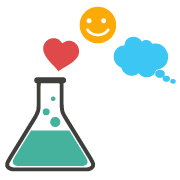Being in flow doesn’t guarantee that the activity we’re doing is good for ourselves, or for the people around us. Most examples of flow activities are positive, but it’s also possible to get into flow squandering your last pennies gambling or bullying someone.
This week is about the benefits of flow, but it’s helpful to keep in mind that those benefits accrue to positive flow activities. Flow is a tool – use it wisely.
More happiness
As mentioned before, we’re not typically “happy” during flow – or sad, or frustrated, or anything really. We’re usually so wrapped up in the activity that we don’t take the time to notice how we feel until afterward – and then we reap the benefits. Adults who spend more time in flow are happier overall. Csikszentmihalyi says that the happiness derived from flow is more under our control than the happiness we get from pleasure or relationships, since it doesn’t necessarily depend on external circumstances or other people.
More positive emotions
“No one ever has a bad time in a flow state,” writes Steven Kotler in The Rise of Superman: Decoding the Science of Ultimate Human Performance.
In one study, people in flow also tended to feel cheerful, strong, active, concentrated, creative, and satisfied. Self-esteem increases after a flow experience, and people who are in flow more often have higher self-esteem overall.
Teenagers, who often struggle to find enough challenge in life, particularly benefit from flow. The more flow a teenager has, the more likely he is to be concentrated, have higher self-esteem, and see what he’s doing as important to future goals during a given moment of work or play. Overall, teenagers with more flow are more optimistic and spend more time with friends, creating cascading benefits.
According to Csikszentmihalyi, flow gives us enjoyment, not pleasure. We feel pleasure when we’re content, comfortable, and doing something familiar, like getting a massage or watching a movie. Enjoyment involves some novelty and requires energy to activate. But once we get started, we can gain confidence and a sense of accomplishment.
Better coping
Focus, one of the prerequisites of flow, is associated with better emotion regulation – a crucial skill when coping with negative emotions and memories. If we know how to tune out distractions at work and hunker down for a big task, we’ll be better at moving on and functioning in life despite a major setback.
The attitude we learn in flow can also be useful for dealing with stress. Flow makes us feel competent, ready to take on the challenges in front of us. It directs our focus outward, rather than inward on our worries, fears, and frustrations. And it helps us learn to choose and move toward goals – even if those goals are to get out of the house daily after the loss of a loved one or eat healthier to cope with cancer. As Kotler explains, flow is such a focused state that our ghosts can’t follow us into it.
Better performance
Top executives report being five times more productive in flow, a McKinsey study found. According to another study by Harvard Business school, creative teams have more breakthroughs in an environment with clear goals and flexibility in how to reach them – precisely the environment that’s conducive to flow. And the day after a flow state, people also report being more creative.
All that makes sense when we look at the brain in flow, which is a more relaxed brain than usual. In flow, our brain waves shift from the beta waves of concentration to the alpha waves associated with rest and relaxation and the theta waves that occur during meditation. And theta waves are the gateway to creative genius, a prerequisite for those aha moments of insight. The fact that our inner critic is silenced during flow also helps our ideas glide effortlessly toward creativity, rather than being judged and discarded.
Flow also enhances learning because it releases dopamine. Dopamine not only gives us a sense of excitement but also helps us notice more patterns in the environment by heightening our attention and decreasing distractions. Once those patterns get stored in our memory during the recovery phase after flow, we’re able to recognize them in new contexts – whether it’s the surfer who just knows which wave to ride or the orchestra conductor who senses that someone needs an extra cue. When trained for flow, experienced snipers zero in on their targets faster, and novices learn to shoot in less time.
Adults who spend more time in flow also spend more time working at the office, rather than gossiping, reading the paper, surfing the Internet, or otherwise avoiding the drudgery of work. As an example of the positive impacts of flow, personal development essay example often discuss how teenagers who spend more time in flow have more productive habits, like studying more often. Flow pushes us to be better, because we will always face the threat of boredom if we stay at the same level.
In this talk, Kotler explains how flow helped him recover from Lyme disease and how flow affects the brain in the best way possible:
Perhaps the biggest benefit we get from flow is a change in the self. Many people live life pursuing the goals they are supposed to pursue, whether those goals come from parents or society or biology. With flow we become an “autotelic self,” one who chooses its own goals and pursues activities for their own sake. We find flow at work, at home, at dinner, in solitude. With expert focus, we pay attention to the world around us and notice more of its beauty and complexity; we’re curious to discover more. We aren’t slaves to fame, fortune, or power, because we don’t need those things to give our lives meaning; the meaning is already there.
